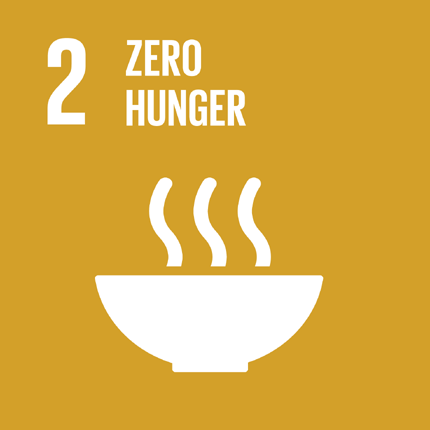sdg2
SUSTAINABLE DEVELOPMENT GOAL 2
End hunger, achieve food security and improved nutrition and promote sustainable agriculture
Progress of goal 2
- Goal 2 aims to end hunger and all forms of malnutrition by 2030. It also commits to universal access to safe, nutritious and sufficient food at all times of the year. This will require sustainable food production systems and resilient agricultural practices, equal access to land, technology and markets and international cooperation on investments in infrastructure and technology to boost agricultural productivity.
- The fight against hunger has progressed over the past 15 years. Globally, the prevalence of hunger has declined, from 15 per cent according to figures for 2000 to 2002, to 11 per cent according to figures for 2014 to 2016. However, more than 790 million people worldwide still lack regular access to adequate amounts of dietary energy. If current trends continue, the zero hunger target will be largely missed by 2030. Many countries that failed to reach the target set as part of the Millennium Development Goals, of halving the proportion of people who suffer from hunger, have faced natural and human-induced disasters or political instability, resulting in protracted crises, with increased vulnerability and food insecurity affecting large parts of the population. The persistence of hunger is no longer simply a matter of food availability. More and better data on access to food can enable the tracking of progress and guide interventions to fight food insecurity and malnutrition.
- Globally, in 2014, nearly 1 in 4 children under the age of 5, an estimated total of 159 million children, had stunted growth. Stunting is defined as inadequate height for age, an indicator of the cumulative effects of undernutrition and infection. Southern Asia and sub-Saharan Africa accounted for three quarters of the children under 5 with stunted growth in 2014. Another aspect of child malnutrition is the growing share of children who are overweight, a problem affecting nearly every region. Globally, between 2000 and 2014, the percentage of children under the age of 5 who were overweight grew from 5.1 per cent to 6.1 per cent.
- Ending hunger and malnutrition relies heavily on sustainable food production systems and resilient agricultural practices. Genetic diversity in livestock breeds is crucial for agriculture and food production since it allows for the raising of farm animals in a wide range of environments and provides the basis for diverse products and services. Globally, 20 per cent of local livestock breeds, meaning breeds reported in only one country, are at risk of extinction. Another 16 per cent of breeds are stable, and the status of the remaining local breeds is unknown owing to a lack of data. The figures exclude livestock breeds that have already become extinct.
- To increase the productive capacity of agriculture, more investment is needed, both public and private, from domestic and foreign sources. However, recent trends in government spending are not favourable. The agriculture orientation index, defined as agriculture’s share of government expenditures divided by the sector’s share of gross domestic product (GDP), fell globally from 0.37 to 0.25 between 2001 and 2013. The decline in the index was interrupted only temporarily during the food price crisis of 2006 to 2008, when governments increased agricultural spending.
- Since the late 1990s, the percentage of aid for supporting agriculture in developing countries has been stable at around 8 per cent, when measured as a share of sector-allocable aid from member countries of the Development Assistance Committee of the Organization for Economic Cooperation and Development (OECD). This has decreased, from a peak of 20 per cent in the mid-1980s, as a result of donors beginning to focus more on improving governance, building social capital and bolstering fragile States.
- One of the targets for Goal 2 calls for correcting and preventing distortions in world agricultural markets, including the elimination of all forms of agricultural export subsidies. Those subsidies mask market signals, reduce competitiveness and can lead to environmental damage and the inequitable distribution of benefits. That said, some progress is being made, with members of the World Trade Organization adopting a ministerial decision, in December 2015, on eliminating export subsidies for agricultural products and restraining export measures that have an equivalent effect.
Source: United Nations, Department of Economic and Social Affairs, SUSTAINABLE DEVELOPMENT KNOWLEDGE PLATFORM
The National Indicators for Sustainable Development Goal 2 are:
- Average income of small-scale food producers, by sex and indigenous status
- Proportion of agricultural area under productive and sustainable agriculture (%)
- Government support to agricultural research and development
- Area under organic farming (in ha)
- Ammonia emissions from agriculture (in tonnes)
All available data in .xls file:
- Zero Hunger
Last Updated: 24/4/2025
EU SDG indicator set
To measure SDG achievement in an EU context, an EU SDG indicator set was developed under the leadership of Eurostat. The purpose of this set, which is structured along the 17 global Sustainable Development Goals, is to monitor progress towards the SDGs at the European level.
- For the complete set of indicators available in the Eurostat database, click here.
- To compare Greece’s progress on specific indicators for each Sustainable Development Goal, click here [data visualisation].

